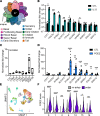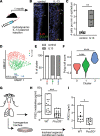IL-13-programmed airway tuft cells produce PGE2, which promotes CFTR-dependent mucociliary function
- PMID: 35608904
- PMCID: PMC9310525
- DOI: 10.1172/jci.insight.159832
IL-13-programmed airway tuft cells produce PGE2, which promotes CFTR-dependent mucociliary function
Abstract
Chronic type 2 (T2) inflammatory diseases of the respiratory tract are characterized by mucus overproduction and disordered mucociliary function, which are largely attributed to the effects of IL-13 on common epithelial cell types (mucus secretory and ciliated cells). The role of rare cells in airway T2 inflammation is less clear, though tuft cells have been shown to be critical in the initiation of T2 immunity in the intestine. Using bulk and single-cell RNA sequencing of airway epithelium and mouse modeling, we found that IL-13 expanded and programmed airway tuft cells toward eicosanoid metabolism and that tuft cell deficiency led to a reduction in airway prostaglandin E2 (PGE2) concentration. Allergic airway epithelia bore a signature of PGE2 activation, and PGE2 activation led to cystic fibrosis transmembrane receptor-dependent ion and fluid secretion and accelerated mucociliary transport. These data reveal a role for tuft cells in regulating epithelial mucociliary function in the allergic airway.
Keywords: Allergy; Chloride channels; Eicosanoids; Inflammation; Pulmonology.
Figures





Similar articles
-
Resveratrol ameliorates abnormalities of fluid and electrolyte secretion in a hypoxia-Induced model of acquired CFTR deficiency.Laryngoscope. 2015 Oct;125 Suppl 7(0 7):S1-S13. doi: 10.1002/lary.25335. Epub 2015 May 6. Laryngoscope. 2015. PMID: 25946147 Free PMC article.
-
Pharmacotherapy of the ion transport defect in cystic fibrosis: role of purinergic receptor agonists and other potential therapeutics.Am J Respir Med. 2003;2(4):299-309. doi: 10.1007/BF03256658. Am J Respir Med. 2003. PMID: 14719996 Review.
-
Modulation of Ion Transport to Restore Airway Hydration in Cystic Fibrosis.Genes (Basel). 2021 Mar 22;12(3):453. doi: 10.3390/genes12030453. Genes (Basel). 2021. PMID: 33810137 Free PMC article. Review.
-
Modulator Combination Improves In Vitro the Microrheological Properties of the Airway Surface Liquid of Cystic Fibrosis Airway Epithelia.Int J Mol Sci. 2022 Sep 27;23(19):11396. doi: 10.3390/ijms231911396. Int J Mol Sci. 2022. PMID: 36232697 Free PMC article.
-
Unified Airway-Cystic Fibrosis.Otolaryngol Clin North Am. 2023 Feb;56(1):125-136. doi: 10.1016/j.otc.2022.09.009. Epub 2022 Oct 18. Otolaryngol Clin North Am. 2023. PMID: 36266104 Review.
Cited by
-
IL-13-associated epithelial remodeling correlates with clinical severity in nasal polyposis.J Allergy Clin Immunol. 2023 May;151(5):1277-1285. doi: 10.1016/j.jaci.2022.12.826. Epub 2023 Feb 2. J Allergy Clin Immunol. 2023. PMID: 36736797 Free PMC article.
-
Tuft Cells: Detectors, Amplifiers, Effectors and Targets in Parasite Infection.Cells. 2023 Oct 18;12(20):2477. doi: 10.3390/cells12202477. Cells. 2023. PMID: 37887321 Free PMC article. Review.
-
Physiological and immunological barriers in the lung.Semin Immunopathol. 2024 Jan;45(4-6):533-547. doi: 10.1007/s00281-024-01003-y. Epub 2024 Mar 7. Semin Immunopathol. 2024. PMID: 38451292 Free PMC article. Review.
-
Tuft cell-derived acetylcholine regulates epithelial fluid secretion.bioRxiv [Preprint]. 2023 Mar 22:2023.03.17.533208. doi: 10.1101/2023.03.17.533208. bioRxiv. 2023. Update in: Immunity. 2024 Jun 11;57(6):1243-1259.e8. doi: 10.1016/j.immuni.2024.03.023. PMID: 36993541 Free PMC article. Updated. Preprint.
-
Injury-induced pulmonary tuft cells are heterogenous, arise independent of key Type 2 cytokines, and are dispensable for dysplastic repair.Elife. 2022 Sep 8;11:e78074. doi: 10.7554/eLife.78074. Elife. 2022. PMID: 36073526 Free PMC article.
References
Publication types
MeSH terms
Substances
Grants and funding
LinkOut - more resources
Full Text Sources
Medical
Molecular Biology Databases

